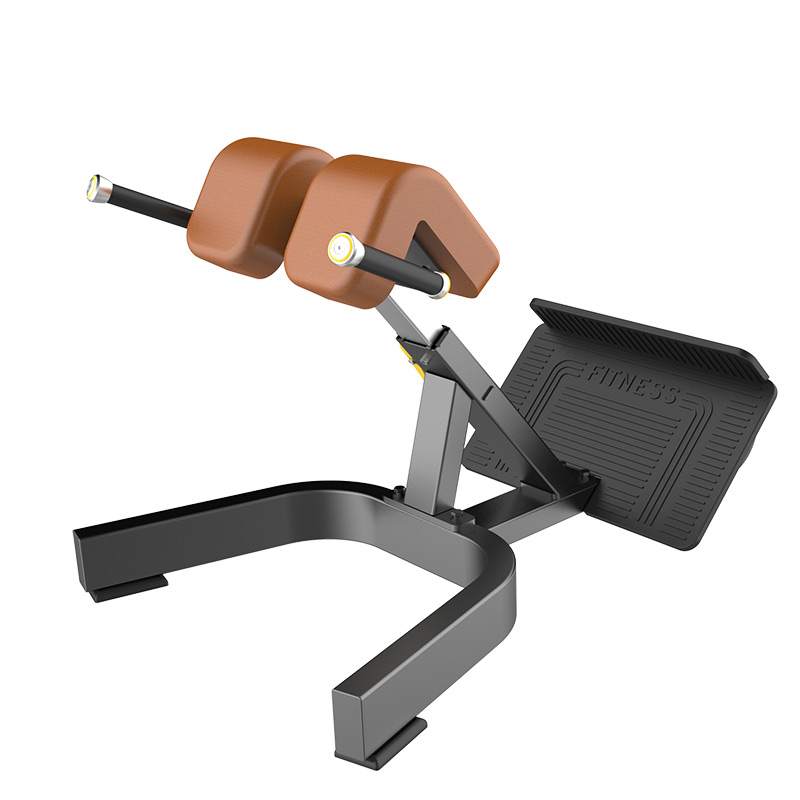The Back Extension, also known simply as the Back Extension machine, is a specialized piece of gym equipment designed to strengthen and tone the lower back muscles, including the erector spinae. It provides a stable platform for performing hyperextension exercises, which are essential for improving lower back strength and stability. Here’s an introduction to its features, benefits, and typical uses:
Features of the Roman Chair Back Extension
- Adjustable Pad: Features an adjustable pad or platform where users lie face down with their hips resting at the edge, allowing for different starting positions and levels of extension.
- Sturdy Frame: Built with a robust frame typically made from steel or heavy-duty materials to provide stability and support during exercises.
- Foot Support: Includes foot supports or ankle pads to secure the lower body and anchor users in place during movements, ensuring safety and proper alignment.
- Padded Cushions: Equipped with padded cushions on the platform and leg supports for comfort during exercises, reducing pressure on the body.
- Compact Design: Designed to be compact and space-efficient, making it suitable for both home gyms and commercial fitness facilities.
Benefits of Using the Roman Chair Back Extension
- Lower Back Strengthening: Targets and strengthens the erector spinae muscles along the lower spine, enhancing lower back strength and stability.
- Core Activation: Engages the core muscles, including the abdominals and obliques, to stabilize the body during the extension movement.
- Improved Posture: Helps to improve posture by strengthening the muscles that support the spine, reducing the risk of lower back pain and injury.
- Muscle Definition: Aids in sculpting and defining the lower back muscles, contributing to a more balanced and aesthetic physique.
- Injury Prevention: Assists in preventing lower back injuries by developing strength and endurance in the muscles that support the spine.
Typical Uses
- Back Extensions: The primary exercise performed on the Roman Chair Back Extension, involving bending forward at the hips and then extending the torso upward against resistance to activate the lower back muscles.
- Hyperextensions: Variations of back extensions that focus on extending the spine beyond the neutral position to increase range of motion and muscle activation.
- Oblique Exercises: Performing side bends or twists while holding a weight plate to engage the oblique muscles and improve core strength and stability.
Proper Usage
- Setup: Adjust the Roman Chair to the appropriate height and ensure it is stable and securely positioned on a flat surface.
- Starting Position: Position yourself face down on the pad with your hips resting at the edge and your feet secured under the foot supports or ankle pads.
- Execution: Lower your upper body towards the floor until your torso is parallel to the ground, then lift your torso back up until your body forms a straight line or slightly hyperextended position. Focus on using your lower back muscles to lift rather than using momentum.
- Breathing: Inhale as you lower your torso towards the floor and exhale as you lift your torso back up during each repetition.
- Repetitions: Complete the desired number of repetitions and sets based on your training goals and fitness level.
Tips for Effective Use
- Warm-Up: Warm up your lower back muscles with light cardio or dynamic stretches before using the Roman Chair Back Extension to prevent muscle strain.
- Proper Form: Maintain a neutral spine throughout the exercise and avoid arching your back excessively. Focus on controlled movements to maximize muscle activation.
- Range of Motion: Ensure a full range of motion by lowering your torso until it is parallel to the ground and lifting until your body forms a straight line or slightly hyperextended position.
- Weight Selection: Start with body weight or light resistance and gradually increase the load as your strength and endurance improve.
- Safety Considerations: Use the foot supports or ankle pads to secure your lower body and maintain stability during exercises. Avoid overextending or forcing the movement beyond your comfort level to prevent injury.





















































Reviews
There are no reviews yet.